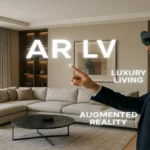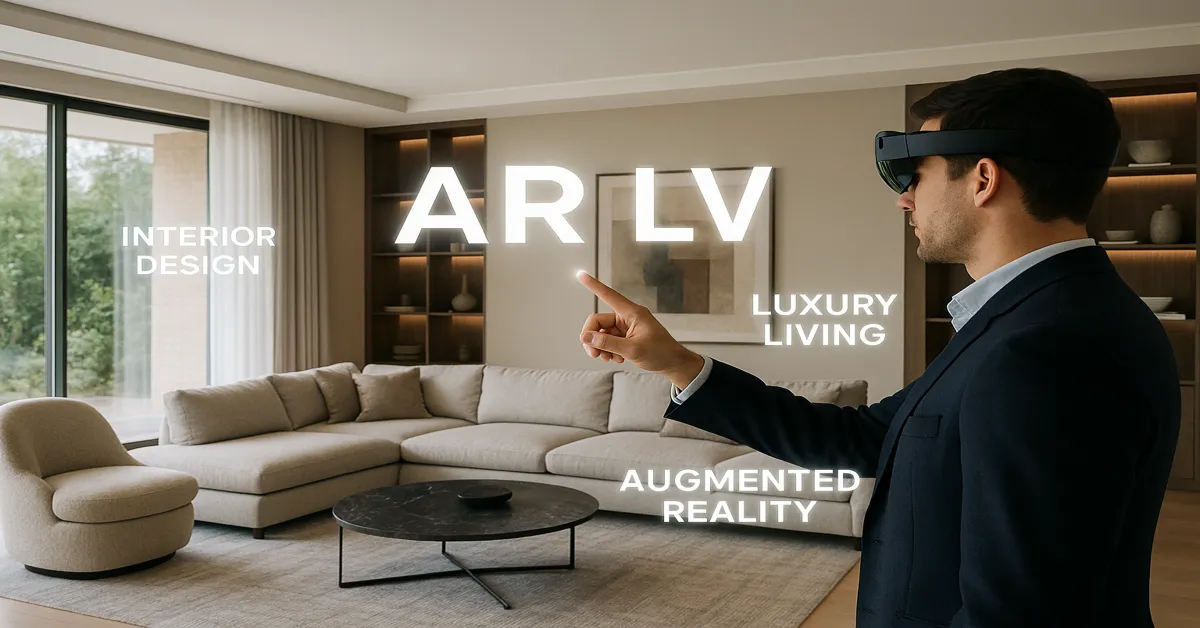In just the past decade, Augmented Reality (AR) has moved from the fringes of tech labs into the hands—and homes—of millions. But its most transformative potential is now unfolding in a sector defined by tradition and tactile experience: Luxury & Lifestyle (LV). From high-end fashion houses deploying AR-powered fitting rooms, to luxury car brands offering immersive configurators, and five-star resorts delivering pre-visit walkthroughs, “AR LV” represents a quiet yet radical redefinition of exclusivity in the digital age.
This article explores how AR is rewriting the rules of luxury—enhancing elegance with interactivity, opulence with personalization, and tradition with technological foresight.
1. Understanding AR LV: A Convergence of Two Worlds
Augmented Reality (AR) superimposes digital elements—images, sounds, data—onto the physical world through devices like smartphones, AR glasses, or headsets. In the luxury world (LV), every detail matters: the stitching on a handbag, the precision in a timepiece, the experience of entering a private villa. Traditionally, these experiences were strictly physical.
AR LV changes that. Now, customers can digitally try on haute couture, walk through a virtual penthouse before purchase, or experience a yacht’s interiors while sitting at home. This is not just about utility—it’s about storytelling, accessibility, and emotional connection.
2. The New Language of Elegance: Digital Personalization
At the heart of luxury is personalization. And AR enables this at a scale and depth previously unthinkable.
2.1. Fashion & Accessories
Brands like Gucci, Dior, and Balenciaga are investing heavily in AR tech. Virtual try-ons powered by AR apps allow customers to “wear” high-end garments or watches in real time. But this goes beyond convenience—it reduces returns, enhances buyer confidence, and provides a new kind of exclusive access.
Digital luxury has moved from gimmick to value-driven innovation. Customers no longer just browse; they experience the product before touching it.
2.2. Interior Design & Real Estate
Ultra-premium interior designers and real estate developers are adopting AR to transform flat blueprints into dynamic, three-dimensional previews. Buyers of high-end condos can use tablets or AR glasses to customize layouts, materials, and furnishings virtually—offering peace of mind and elevating anticipation before the actual build.
3. The Virtual Showroom: Reimagining Retail Without Borders
Physical showrooms in Paris or Milan may still be cultural landmarks, but AR-powered virtual showrooms democratize access. For aspirational buyers in emerging luxury markets, AR LV bridges the distance between aspiration and experience.
3.1. Immersive Flagships
Some luxury brands have launched interactive flagship stores online, where customers navigate spaces like avatars in a high-end video game. Each “room” displays seasonal collections, art collaborations, and even brand history—replicating the ambiance of visiting a boutique on Avenue Montaigne.
3.2. Limited Edition Drops
AR is also being used for exclusivity activation. Luxury labels now drop limited edition pieces that can only be previewed through AR filters or accessed through geo-specific AR experiences—merging FOMO (fear of missing out) with high fashion.
4. Travel & Hospitality: The Augmented Voyage
Nowhere is lifestyle more curated than in luxury travel. And AR is becoming central to how destinations present themselves and personalize offerings.
4.1. Immersive Previews
Five-star resorts and private villa rentals offer AR walk-throughs of suites, pools, and spa facilities. Some go further—allowing guests to change lighting, view room service menus, or explore views from different windows.
4.2. Destination Discovery
Travel agencies and tourism boards are leveraging AR to let users “stand” at the edge of Santorini cliffs or “walk” through Tokyo streets. These virtual encounters fuel emotional connection and booking confidence—especially for high-end travelers who prioritize curated detail.
5. Collectibles, NFTs, and the AR Vault
Luxury is also about rarity, and in the digital space, that has birthed a new frontier: collectible digital assets.
5.1. AR-Enabled NFTs
Luxury brands are releasing NFTs that come with AR components. Think: a virtual-only handbag that can be worn on Instagram through AR filters or a digital art piece embedded with interactive elements.
5.2. Virtual Vaults
Collectors of rare watches or jewelry are beginning to use AR vaults—digital rooms or safes where 3D versions of their real-world items are stored. Some use blockchain to authenticate, but the draw is aesthetic: being able to showcase a personal collection in stunning AR environments.
6. The Role of Data: Precision With Privacy
As luxury brands embrace AR, they also gather behavioral and preference data—what colors users gravitate toward, how long they view certain items, even facial expressions captured by cameras.
But high-end consumers expect discretion. The challenge for AR LV is to collect data ethically while offering tailored experiences. Brands are increasingly transparent about data use, offering opt-outs or private browsing modes that align with luxury’s longstanding respect for client confidentiality.
7. The Rise of AR in Luxury Automotives
Luxury cars are a natural fit for AR integration—not only in how they’re presented, but how they function.
7.1. Virtual Car Configurators
AR lets customers customize color, interior finishes, wheel types, and even test-drive a model from their driveway. Companies like Ferrari and Aston Martin have adopted this to reach global clients without physical test centers.
7.2. In-Car AR HUDs
Inside the vehicles, AR-powered heads-up displays (HUDs) project navigational cues, safety warnings, or concierge features onto windshields—merging form and function in a seamless, futuristic experience.
8. Sustainability in Luxury: AR’s Quiet Contribution
Sustainability is no longer optional in luxury—it’s expected. AR contributes by reducing waste and environmental impact in several ways:
- Fewer physical samples in fashion and home design
- Reduced need for international travel to view properties or collections
- Digital prototyping before physical manufacturing
By enhancing the virtual experience, AR LV helps minimize overproduction and undercuts the fast fashion model with more deliberate, tailored production cycles.
9. Challenges of AR LV: Not All That Glitters Is Gold
While the AR LV landscape is inspiring, it’s not without challenges.
- Accessibility barriers: AR experiences may require high-end devices
- Digital fatigue: Over-reliance on virtual encounters can dilute emotional connection
- Authenticity questions: Purists argue that true luxury lies in touch, not pixels
Yet these critiques often drive innovation, encouraging brands to balance digital ingenuity with physical elegance.
10. Looking Forward: What’s Next for AR LV?
As AR hardware becomes more accessible—especially with the advent of mixed reality headsets and smart glasses—the barrier between digital and physical luxury will continue to dissolve.
Future Predictions:
- Virtual trunk shows with live AR interactions
- Hyper-personalized concierge services powered by AI and AR
- Augmented social gatherings—private digital salons with real-world product fulfillment
The ultimate goal isn’t to replace luxury’s tactile essence, but to enhance and amplify it in ways that feel bespoke, meaningful, and emotionally intelligent.
Final Thoughts: AR LV Is Not a Trend—It’s a Transformation
Luxury has always evolved—embracing railroads, air travel, smartphones, and now, augmented reality. The AR LV movement is not about turning away from craftsmanship, but rather about adding new dimensions to it.
What used to be a boutique appointment or a passport stamp can now begin with a swipe, a scan, or a holographic projection. As the boundaries between digital and physical continue to blur, AR LV stands at the crossroads—offering a future where technology doesn’t cheapen luxury, but elevates it.
Read: How to Extend the Service Life of Industrial Laboratory Equipment
FAQs
1. What does “AR LV” mean?
“AR LV” refers to the use of Augmented Reality (AR) technologies within the Luxury and Lifestyle (LV) sector. It includes AR applications in fashion, high-end retail, luxury travel, real estate, automobiles, and personalized digital experiences designed to enhance exclusivity, interaction, and convenience.
2. How is AR being used in luxury fashion and retail?
Luxury fashion brands use AR for virtual try-ons, immersive runway shows, and interactive product displays. Customers can view how clothing or accessories look on them in real time, enhancing confidence and reducing returns—all without stepping into a store.
3. Is AR only used for marketing in luxury, or does it have practical applications?
AR is used for both marketing and practical utility. Beyond engaging campaigns, AR helps customers preview luxury homes, configure custom cars, tour five-star hotel rooms, and visualize interior design options—all with high personalization and minimal waste.
4. Are AR experiences accessible to all luxury consumers?
While AR is becoming more widespread, it still requires compatible devices like smartphones or AR glasses. Leading brands are working to make experiences more seamless, but accessibility varies by region and device quality.
5. How does AR contribute to sustainability in the luxury sector?
AR reduces the need for physical prototypes, samples, and travel, cutting down on waste and emissions. It supports more efficient production processes and encourages thoughtful purchasing, aligning with sustainability goals without compromising luxury standards.







